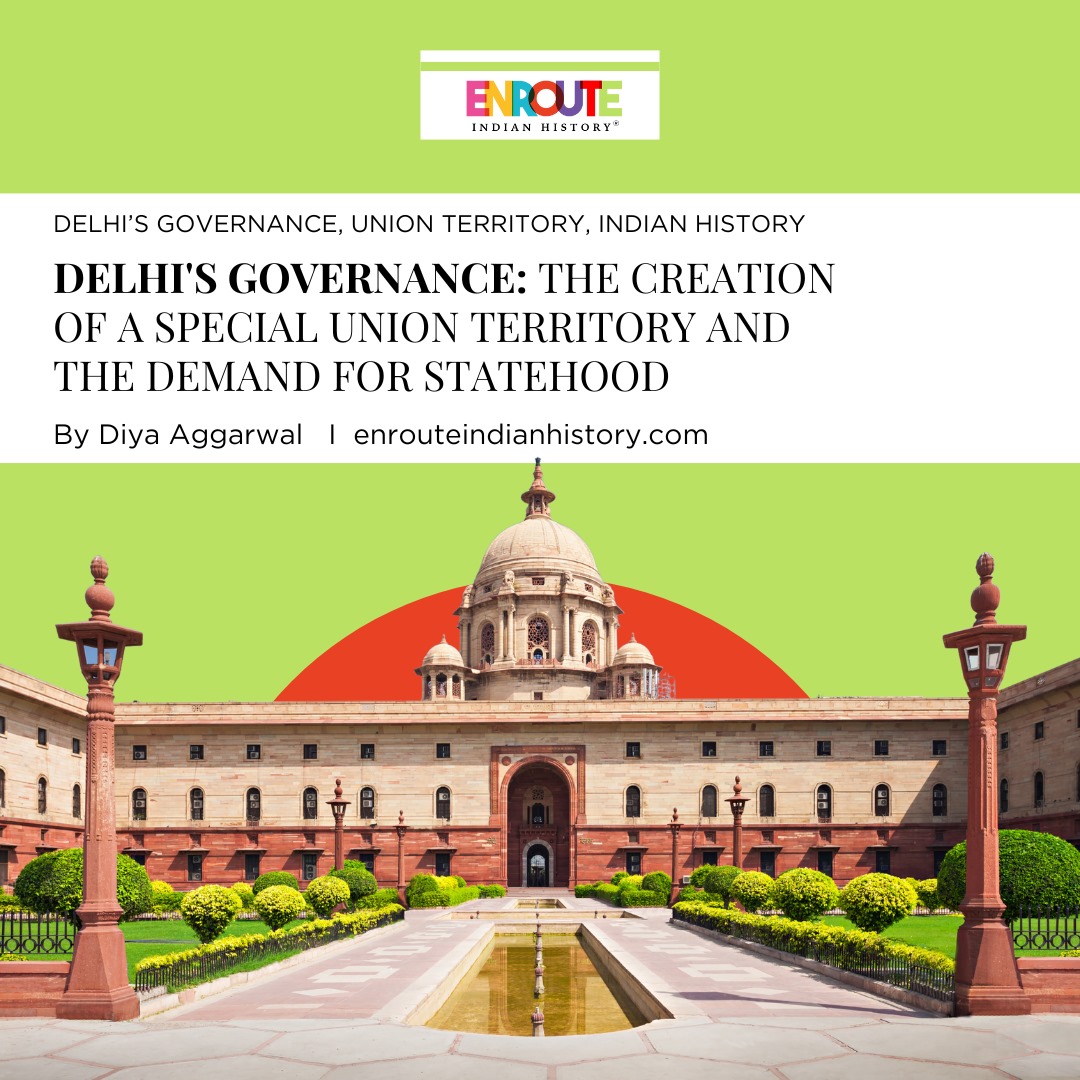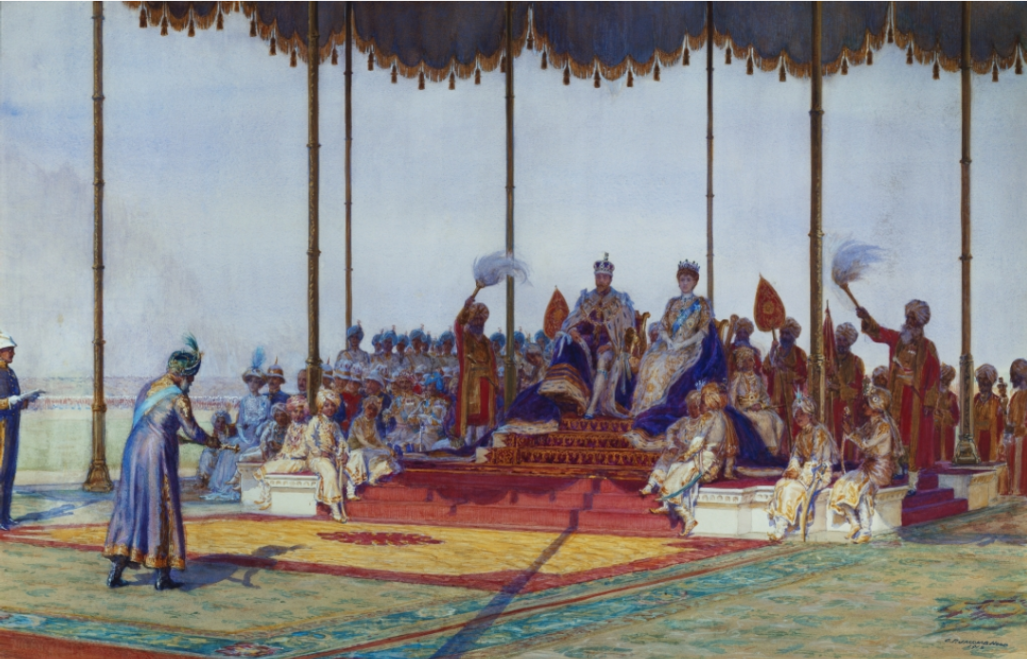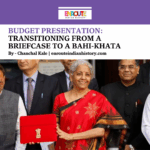Delhi’s Governance: The Creation of a Special Union Territory and the Demand for Statehood
- EIH User
- May 1, 2024

Delhi, the capital of India, is more than just a city; it’s a political and administrative hub that plays a crucial role in the nation’s governance. Delhi’s governance is a testament to the ever-evolving governance landscape in the context of Indian history. With a history, spanning from the twilight years of the Mughal Empire to its current status as a Union Territory (UT) with a special administrative framework, Delhi’s governance history reflects the complex interplay of political, social, and historical forces.
BEFORE THE REVOLT OF 1857
In the aftermath of the decline of the Mughal Empire, Delhi found itself at the crossroads of competing regional powers, each vying for control over the strategic city. This era witnessed a tumultuous struggle for dominance, with the Marathas, British East India Company, and other local rulers seeking to establish their authority over the remnants of Mughal influence. Over time, the East India Company evolved from being primarily a group of merchants to assuming the role of a significant regional power in India. Despite nominally being under the rule of the Mughal emperor, it became the “primus inter pares” among India’s rulers.

(Illustrated London News. Jan 16, 1858. p. 52; Wikimedia Commons – The City of Delhi before the siege in 1857)

(Sir Thomas Metcalfe, Reminiscences of Imperial Dehlie; British Library, Victorian Web – East face of the palace of the Red Fort Delhi. 1843. Ink and colors on paper.)
From 1803 onwards, the Mughal monarch’s actual power was limited to the Red Fort only. Delhi’s governance and administration came under the purview of the British East India Company – ranging from collecting revenue to maintaining peace and order. This Residency system introduced a duality in Delhi’s governance, where the English Resident and his administration sought to exert maximum control over civil affairs while maintaining a facade of deference to the Mughal empire. The Residency system was a form of indirect rule used by the British East India Company in colonial India. A British official called the Resident or Political Agent would be stationed at a princely state or regional chief’s court, advising and influencing the local ruler while maintaining the appearance of local autonomy. However, this pretense was abandoned after 1835, as the British Residency began assertively seeking concessions from the Mughal court and openly disregarding its protocols. The British ruled over Delhi through this facade of a Residency system till they were hit by the Revolt of 1857.
POST THE REVOLT OF 1857
After the Revolt of 1857, as the British reestablished control over Delhi, they made Delhi a provincial town of the Frontier Province. They later transferred it to the newly formed Punjab province under a Lieutenant Governor with the Delhi and Hissar divisions containing the six districts of Delhi, Gurgaon, Panipat, Rohtak, Hissar, and Sirsa. British forces presented it to the Punjab province, under the Government of India Act 1858, for their loyalty during the revolt. This Punjab province included the present-day Indian states of Punjab, Haryana, Chandigarh, and Delhi along with the Pakistani regions of Punjab, Islamabad Capital Territory, and Khyber Pakhtunkhwa. Interestingly, St. Stephen’s College, Hindu College, and Ramjas College were all a part of the Punjab University in Lahore before they became the constituent colleges of the University of Delhi in 1922.

(George Percy Jacomb, The Heritage Lab – A painting of the 1911 Delhi Durbar)
Delhi’s governance journey as the capital of India began in 1911. At a durbar in Delhi to celebrate his coronation as the emperor, King George V announced his decision to transfer the capital of British India from Calcutta to Delhi. Done primarily to escape Calcutta’s violent and unsettling political atmosphere, this transfer was not one without criticisms and controversies. Some thought it unconstitutional, while some praised the decision for symbolizing anew that India would be governed solely for the benefit of its people.
In 1912, through the Delhi Laws Act, Delhi’s governance and administration shifted from the Punjab province to the separate province of Delhi to be exercised by a Chief Commissioner. It continued to be administered directly by the Government of India through a Chief Commissioner till 1950.
POST-INDEPENDENCE
On July 31, 1947, a committee chaired by Dr. B. Pattabhi Sita Ramayya was established to delve into and provide recommendations on the constitutional adjustments needed for the administrative structure of the Chief Commissioner’s Provinces, which included Delhi. Following the committee’s report, the Constituent Assembly introduced Articles 239 and 240 into the constitution, enabling Part-C states to operate under the leadership of a Chief Commissioner or Lieutenant Governor. They recommended a separate self-government in Delhi, consisting of a three-member Council of Ministers to assist the Lieutenant Governor, and a 50-member Legislative Assembly empowered to enact legislation on all subjects listed in the State and the Concurrent List. Consequently, Delhi attained the status of a Part-C state in 1951, equipped with both a Council of Ministers and a Legislature. Part-C states were simply former Chief Commissioner’s provinces governed by the Chief Commissioner, appointed by the President of India. In 1952, the Delhi Legislative Assembly was established. It operated as a directly elected unicameral legislature, with seats reserved for scheduled castes. However, it was not allowed to legislate on matters relating to public order, police (including railway police), the constitution of and powers of municipal corporations and local authorities.

(Furfur, Wikimedia Commons. Political map of India, 1956, after the States Reorganisation Act and the Bihar and West Bengal (Transfer of Territories) Act.)
With the State Reorganisation Act, 1956, Indian states were categorized simply as “States and Union Territories,” replacing the previous classification system of Part A, B, C, and D States. The States Reorganisation Commission, established in December 1953, proposed that Delhi, being the national capital, should remain under the direct control of the central government. Consequently, the Council of Ministers and Legislative Assembly of Delhi were dissolved on November 1, 1956. Delhi, functioning as a Union Territory, was thereafter governed by the President of India through a Chief Commissioner appointed under Article 239 until the Delhi Administration Act 1966 was enacted. The Delhi Administration Act 1966 provided for limited representation in Delhi’s governance. This was done through the establishment of a Metropolitan Council consisting of 56 elected members and 5 nominated members. An Order issued by the Ministry of Home Affairs specified that the Lieutenant Governor, Administrator, or Chief Commissioner would all be subject to the control of the President.
It was against the backdrop of the shortcomings and inherent deficiencies of the Metropolitan Council, primarily the problem of having no legislative powers and only an advisory position in Delhi’s governance, that the demand for statehood for Delhi gained momentum. Due to the increasing population in the capital city, it was highlighted that a representative democratic system must be established to protect the rights of the general populace. The opposition rested on the fact that granting statehood to Delhi could exacerbate conflicts between the Central and State Governments, potentially hindering the efficient operation of the national capital territory.
IN CONTEMPORARY TIMES
A subsequent change to Delhi’s governance came in 1989 with the report of the Balakrishnan Committee, set up in 1987 and headed by S. Balakrishnan. The report squashed the demand for statehood and proposed that Delhi should retain its status as a Union Territory but should be granted a Legislative Assembly with sufficient authority to address the needs of the general populace. The Legislative Assembly was given the power to make laws for the entire or any specific area on subjects listed in the State list, except for matters related to land, police, and public order. Additionally, the committee suggested that to ensure stability and permanence, this arrangement should be included in the constitution to grant the National Capital a special status among the Union Territories. These recommendations were incorporated into the Constitution through the Constitution (69th Amendment) Act, 1991, and the Government of National Capital Territory of Delhi Act, 1991. As a result, Delhi was officially designated as the “National Capital Territory of Delhi” under the constitution, and its administration would be overseen by a Lieutenant Governor (LG) appointed by the President. Furthermore, a Legislative Assembly was established.
From its roots as a center of power during the Mughal Empire to its evolution into the National Capital Territory of India, Delhi has witnessed significant transformations over the centuries. Delhi’s governance continues to be plagued with the demand for statehood even now. In 2018, the Supreme Court overturned the ruling of the Delhi High Court and ruled that the executive head of the National Capital Territory (NCT) is the Chief Minister, not the LG. The LG is obligated to follow the ‘aid and advise’ of the Council of Ministers on all matters within the purview of the Delhi Assembly’s legislative authority. Delhi is still embroiled in a battle between the Union and the State government over the extent of legislative powers and executive powers of the Delhi government.
In navigating these complexities, it is imperative to strike a balance between ensuring effective governance and respecting the unique status of Delhi as the national capital. The path forward for Delhi’s governance must prioritize the welfare and aspirations of its residents while upholding the principles of democratic governance and constitutional integrity.
REFERENCES
- Kaur, N. (2018). “Delhi, a history of governance: A look back at the legal journey from 1858 to 2018.” The Leaflet. [online] theleaflet.in.
- web.archive.org. (2017). “PUNJAB SETTLEMENT MANUAL.” [online]
- Jain, C. S. (1973). “THE CHANGE OF CAPITAL IN 1911.” Proceedings of the Indian History Congress, vol. 34, pp. 45–47. JSTOR.
- Roychowdhury, A. (2023). “Statehood for Delhi: Tracing the history and legal journey since 1911.” [online] The Indian Express.
- Arshi, N. (2012). “EXPANSION OF COLONIAL AUTHORITY IN THE CITY OF DELHI, 1803 – 1856: A STUDY OF GRANTS, ENDOWMENTS AND URBAN SPACE.” Proceedings of the Indian History Congress, vol. 73, pp. 528–537. JSTOR.
- Planning Department, Government of NCT of Delhi. “Economic Survey 2003-04.” [online] https://delhiplanning.delhi.gov.in/sites/default/files/Planning/economic-survey-2003-04/ch1.pdf
- Fisher, M. H. (1984). “Indirect Rule in the British Empire: The Foundations of the Residency System in India (1764-1858).” Modern Asian Studies, vol. 18(3), pp. 393–428. JSTOR.
- Government of NCT of Delhi. “LEGISLATIVE ASSEMBLY OF NATIONAL CAPITAL TERRITORY OF DELHI.” [online] https://delhiassembly.delhi.gov.in/sites/default/files/dlas/pdf/aboutdelhiassembly_1.pdf
- Parthasarathy, M. (2022). “Special Status of Delhi: A Timeline.” [online] Supreme Court Observer.
Lahiri, N. (2003). “Commemorating and Remembering 1857: The Revolt of Delhi and its Afterlife.” World Archaeology, vol. 35, no.1, pp 35-60.



















